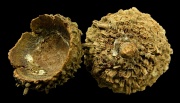Difference between revisions of "Acorn"
Jump to navigation
Jump to search
(username removed) |
|||
| (3 intermediate revisions by 3 users not shown) | |||
| Line 2: | Line 2: | ||
== Description == | == Description == | ||
| − | A natural brown dye can be extracted from acorns similar to dyes obtained from [ | + | A natural brown dye can be extracted from acorns similar to dyes obtained from [[oak%20bark|oak bark]]. |
| − | See [ | + | See [[quercitron|quercitron]]. |
== Synonyms and Related Terms == | == Synonyms and Related Terms == | ||
| Line 10: | Line 10: | ||
ghianda (It.), ''tsurubami'' (Jap.), ''kunugi'' (Jap.) | ghianda (It.), ''tsurubami'' (Jap.), ''kunugi'' (Jap.) | ||
| − | == | + | ==Resources and Citations== |
| − | * | + | * R.J. Adrosko, ''Natural Dyes in the United States'', Smithsonian Institution Press, Washington, DC, 1968 |
[[Category:Materials database]] | [[Category:Materials database]] | ||
Latest revision as of 15:14, 23 April 2022
Description
A natural brown dye can be extracted from acorns similar to dyes obtained from Oak bark.
See Quercitron.
Synonyms and Related Terms
ghianda (It.), tsurubami (Jap.), kunugi (Jap.)
Resources and Citations
- R.J. Adrosko, Natural Dyes in the United States, Smithsonian Institution Press, Washington, DC, 1968
